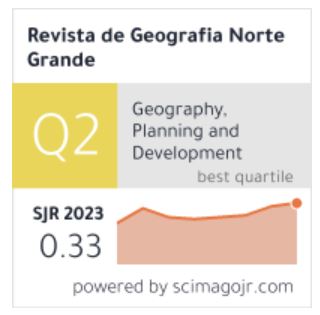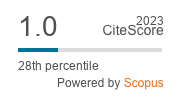Estratificación de la densidad urbana y seguimiento de las islas de calor: Caso de la ciudad de Tijuana.
Palabras clave:
Estratificación de la densidad urbana, temperaturas de la superficie del suelo, islas de calor, Ciudad de TijuanaResumen
La densificación de los espacios urbanos reduce la disipación calorífica propiciando la aparición de islas de calor urbano (ICU) que contribuyen al deterioro ambiental y la disminución del bienestar de la población. Este fenómeno se manifiesta con el incremento de temperaturas de la superficie del suelo (TSS) como consecuencia del consumo de los espacios permeables al calor debido a la expansión y densificación de la ciudad. Aprovechando los atributos radiométricos y térmicos de las imágenes LANDSAT, esta investigación analizó la incidencia de la estratificación de la densidad urbana entre 1987-2018 sobre la dinámica de las TSS en la ciudad de Tijuana, Baja California. De manera especifica, se procedió a la validación estadística de una posible relación entre clases de densidad urbana y sus respectivas TSS. Los resultados parecen indicar que la estratificación de densidades urbanas es una aproximación de muchas enseñanzas para descifrar la dinámica del paisaje urbano. No obstante, no es la herramienta adecuada para discriminar coberturas del suelo por medio de las TSS.
Descargas
Citas
AMIRTHAM, L.R., DEVADAS, M.D. & PERUMAL, M., 2009. Mapping of micro-urban heat islands and land cover changes: a case in Chennai City, India. International Journal of Climate Change: Impacts and Responses, 2009, Vol.1, N°2, p.71–84.
ANDRAS, V. & HAROLD, D. The Kruskal-Wallis Test and Stochastic Homogeneity. Journal of Educational and Behavioral Statistics, 1988, Vol.23, N°2, p.170-192.
BARSI, J.A., SCHOTT, J.R., HOOK, S.J., RAQUENO, NG., MARKHAM, B.L. & RADOCINSKI, R.G. Landsat-8 thermal infrared sensor (TIRS) vicarious radiometric calibration. Remote Sensing, 2014, Vol.6, N°11, p.11607–11626.
BOGOLIUBOVA, A. & TYMKÓW, P. Accuracy assessment of automatic image processing for land cover classification of St. Petersburg protected area. Acta Scientiarum Polonorum. Geodesia et Descriptio Terrarum, 2014, Vol.13, N°1–2, p.5-12.
BOKAIE, M., ZARKESH, M.K., ARASTEH, P.D. & HOSSEINI, A. Assessment of Urban Heat Island based on the relationship between land surface temperature and Land Use/ Land Cover in Tehran. Sustainable Cities and Society, 2016, N° 23, pp.94–104.
CONGALTON, R. G. 1991. A review of assessing the accuracy of classifications of remotely sensed data. Remote Sensing of Environment, 1991, Vol. 37, N°1, p.35–46.
DENGSHENG, L. & QIHAO, W. Urban Classification Using Full Spectral Information of Landsat ETM+ Imagery in Marion County, Indiana. Photogrammetric Engineering and Remote Sensing, 2005, Vol.71, N°11, p.1275-1284.
DEVALSAM IMOKE, E., JOSEPH IBU, U. & ARIKPO ETTA, U. The influence of topography on the distribution of urban heat island effect in calabar metropolis. International Journal of Research In Earth y Environmental Sciences, 2014, Vol.2, N°1, p.1-7.
ESTOQUE, R.C., MURAYAMA, Y. & MYINT, S.W. Effects of landscape composition and pattern on land surface temperature: An urban heat island study in the megacities of Southeast Asia. Science of the Total Environment, 2017, Vol. 577, p.349–359.
FREITAS, E.D., ROZOFF, C.M., COTTON, W.R. & SILVA, P.L. Interactions of an urban heat island and sea-breeze circulations during winter over the metropolitan area of São Paulo, Brazil. Boundary-Layer Meteoroloy, 2007, Vol.122, N°1, p.43-65.
GAUTHIER, T. Detecting Trends Using Spearman's Rank Correlation Coefficient. Environmental Forensics, 2001, Vol.2, N°4, p.359-362.
GOUERY, P. & HUBERT, L. Segmentation et petit parcellaire : Application à des images Landsat et Spot sur la région de l’estuaire de la Rance (France). Photo-interprétation, 1990, Vol.3 et 4, p.4-9.
HARALICK, R.M. Statistical image texture analysis. En: Young, T.Y. y Fu, K.S. (EDITORES). Handbook of pattern recognition and image processing. Orlando, Florida: Academic Press. 1986, p. 247-279.
HAUKE, J. & KOSSOWSKI, T. Comparison of values of Pearson’s and Spearman’s correlation coefficients on the same sets of data. Quaestiones Geographicae, 2011, Vol.30, N°2, p.87-93.
HINTZ, M.J., LUEDERITZ, C., LANG, D.J. & VON WEHRDEN, H. Facing the heat: A systematic literature review exploring the transferability of solutions to cope with urban heat waves. Urban Climate, 2018, Vol.24, p.714–727.
HU, T., YANG, J., LI, X. & GONG, P. (2015). Mapping Urban Land Use by Using Landsat Images and Open Social Data. Remote Sensing, 2015, Vol.8, N°151, p.1-18.
INEGI. Prontuario de información geográfica municipal de los Estados Unidos Mexicanos. México: Instituto Nacional de Estadística y Geografía, 2009.
INEGI. Censo de Población y Vivienda 2010. Instituto Nacional de Estadística y Geografía. México: Instituto Nacional de Estadística y Geografía, 2012.
JÁUREGUI OSTOS, O. Climatología de difusión de la ciudad de Tijuana, B. C. Investigación Geográfica, 1981, N°11, p.55-91.
KAWASHIMA, S., ISHIDA, T., MINOMURA, M. & MIWA, T. Relations between surface temperature and air temperature on a local scale during winter nights. Journal of Applied Meteorology, 2000, Vol. 39, N°9, p.1570–1779.
KOTHARKAR, R., RAMESH, A. & BAGADE, A. Urban Heat Island studies in South Asia: A critical review. Urban Climate, 2018, Vol. 24, p.1011–1026.
MALLICK, J., KANT, Y. & BHARATH. B.D. Estimation of land surface temperature over Delhi using Landsat-7 ETM+. The Journal of Indian Geophysical Union, 2018, Vol.12, N°3, p.131-140.
METWALLI, M.R., NASR, A.N., FARAG ALLAH, O.S., EL-RABAIE, S. & ABD EL-SAMIE, F. Satellite image fusion based on principal component analysis and high-pass filtering. Journal of the Optical Society of America A, 2010, Vol. 27, p.1385-1394.
MYINT, S.W. A Robust Texture Analysis and Classification Approach for Urban Land‐Use and Land‐Cover Feature Discrimination, Geocarto International, 2001, Vol.16, N°4, p. 29-40.
OKE, T.R. (1982). The energetic basis of the urban heat island. Quarterly Journal of the Royal Meteorological Society, 1982, Vol.108, N°455, p.1–24.
OSTERTAGOVA, E., OSKAR, O. & JOZEF, K. Methodology and Application of the Kruskal-Wallis Test. Applied Mechanics and Materials, 2014, Vol. 611. p.115-120.
PAL, S. & ZIAUL, S. Detection of land use and land cover change and land surface temperature in English Bazar urban center. The Egyptian Journal of Remote Sensing and Space Sciences, 2017, Vol. 20, p.125-145.
PENG, Y. & MA, Y. (2018). A level set Method to image segmentation based on local direction gradient. Transactions on Internet and Information Systems, 2018, Vol.12, N°4, p.1760-1776.
PHIRI, D. & MORGENROTH, J. Developments in Landsat Land Cover Classification Methods: A Review. Remote Sensing, 2017, Vol.9, N°9. DOI:10.3390/rs9090967.
POTERE, D. Horizontal positional accuracy of Google Earth’s high-resolution imagery archive. Sensors, Vol.8, N°12, p.7973–7981.
REA, L. M., y PARKER, R. A. Designing and conducting survey research: a comprehensive guide. San Francisco: Jossey-Bass Publishers, 1992.
SAKTHIVEL, M., VIJAYAKUMAR, S., MURUGESAN, S., PUSHPARAJ, S.S. & RAMACHANDRAN, K. Analysis of urban heat island intensities a case study in Chennai metropolitan. International Journal of Geomatics and Geosciences, 2014, Vol.5, N°1, p.19–30.
SPP. X Censo General de Población y Vivienda 1980. México: Coordinación general del sistema nacional de información, Dirección general de estadística, 1986.
SERRA SILVA, J., MARQUES DA SILVA, R. & GUIMARÃES SANTOS, C.A. Spatiotemporal impact of land use/land cover changes on urban heat islands: A case study of Paço do Lumiar, Brazil. Building and Environment, 2018, Vol.136, p.279–292.
SHARMA, R., CHAKRABORTY, A. & JOSHI, P.K. Geospatial quantification and analysis of environmental changes in urbanizing city of Kolkata (India). Environmental Monitoring and Assessment, 2015, Vol.187, N°1. DOI:10.1007/s10661-014-4206-7.
SOBRINO, J.A., JIMENEZ-MUNOZ, J.C. & PAOLINI, L. Land surface temperature retrieval from LANDSAT TM 5. Remote Sensing of Environment, 2004, Vol.90, p.434–440.
SOBRINO, J.A., JIMÉNEZ-MUÑOZ, J.C., SÒRIA, G., ROMAGUERA, M., GUANTER, L., MORENO, J. & MARTÍNEZ, P. Land surface emissivity retrieval from different VNIR and TIR sensors. IEEE Transactions on Geoscience and Remote Sensing, 2008, Vol.46, p.316–327.
TOMCZAK, M. & TOMCZAK, E. 2014. The need to report effect size estimates revisited. An overview of some recommended measures of effect size. Trends in Sport Sciences, 2014, Vol.1, N°21, p.19-25.
USGS. Landsat collection 1 level 1 product definition. Sioux Falls, South Dakota: United States Geological Survey, EROS, 2017.
USGS. Landsat 8 (L8). Data users handbook. Sioux Falls, South Dakota: United States Geological Survey, EROS, 2018.
EPA. Reducing Urban Heat Islands: Compendium of Strategies. Washington, D.C: US Environmental Protection Agency, 2008.
YOUNG, N.E., ANDERSON, R.S., CHIGNELL., S.M., VORSTER, A.G., LAWRENCE, R. & EVANGELISTA, P.E. A survival guide to Landsat preprocessing. Ecology, 2017, Vol.98, N°4, p.920–932.
ZAR, J. H. (2005). Spearman Rank Correlation. En: Armitage, P. y Colton, T. (EDITORES). Encyclopedia of Biostatistics, 2nd ed., Vol. VII. Hoboken, N.J: Wiley, 2005, p. 5095-5105.
ZHANG, X., ESTOQUE, R. & MURAYAMA, Y. An urban heat island study in Nanchang City, China based on land surface temperature and social-ecological variables. Sustainable Cities and Society, 2017, Vol.32, p.557–568.
Descargas
Publicado
Cómo citar
Número
Sección
Licencia
Derechos de autor 2022 Revista de Geografía Norte Grande

Esta obra está bajo una licencia internacional Creative Commons Atribución 4.0.







